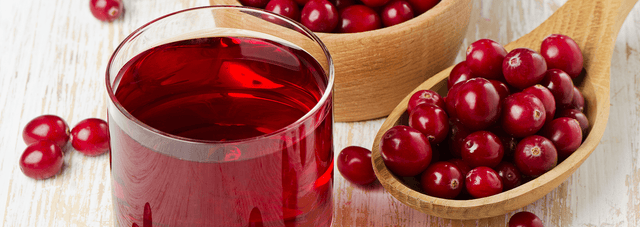Rich in fiber, vitamin C, and plenty of powerful plant nutrients, cranberries are an impressive fruit. But they have one specific nutrient that makes them especially unique – they’re the only fruit known to contain soluble A-type proanthocyanidins (PACs). This particular type of PAC can help support urinary tract health.*
Now enters the question: which is better to help promote urinary tract health – cranberry juice or a cranberry supplement?
Take a deep dive into the world of cranberry to learn four truths about juice and arm yourself with the knowledge to help you make the best decision.
1. Cranberry juice is confusing.
If you’ve strolled through the juice aisle of your local grocery store, you understand. There are so many cranberry juice varieties, and if you’re on a mission to help support urinary tract health, it can be difficult to choose the best option. You’ll see the shelves sprinkled with terms like “100% juice,” “cranberry juice cocktail,” and “unsweetened cranberry juice.” What does it all mean?
Let’s break it down.
100% juice cranberry: You’ve probably heard the advice to always choose 100% fruit juice – typically, that’s a pretty good rule of thumb. So, when you spot a bottle of cranberry juice labeled “100% juice,” it seems like the perfect option. But labels are sneaky. Most of the time, this type of cranberry juice is mixed with other juices like apple, grape, and pear to make it sweeter and more palatable. It is indeed 100% juice, just not 100% cranberry juice. Make sure you double-check the label and the ingredients list if you’re looking for a product that contains only cranberry juice.
Cranberry juice cocktail: This variety is the most well-known cranberry juice and the type most people end up putting in their grocery cart. Cranberries are the only fruit in this juice, but since other fruit juices aren’t added as a sweetener, sugar or high-fructose corn syrup is added instead. Most cranberry juice cocktails are only 27% cranberry juice – the rest is typically water and sugar.
Unsweetened 100% cranberry juice: This type of cranberry juice may also be called “pure cranberry juice.” It doesn’t contain any form of sweetener – no sugar, high-fructose corn syrup, or any other kind of fruit juice. Cranberries are naturally low in sugar, so the final product is extremely tart.
2. You have to drink quite a bit of juice to reap the benefits.
Most research suggests that 8-10 ounces of at least 27% cranberry juice can help support urinary tract health – but as with most things, consistency is key. That means for the most benefit, you would need to drink cranberry juice daily. Over time, that adds up.
A typical eight-ounce serving of cranberry juice cocktail (27% fruit juice) contains about 110 calories. While that doesn’t seem like a huge amount, it’s not all about calories. It’s important to look at overall dietary patterns.
The 2020-2025 Dietary Guidelines for Americans (DGA) recommends that at least half of your fruit intake should be from whole fruits instead of juice. Most adults should aim to eat about 2 cups of fruit per day, so one cup of cranberry juice takes up your entire juice allotment for the day. And when you opt for juice over the whole fruit, you’re missing out on important nutrients like fiber that help support gut health.
3. Juice has more sugar than cranberry supplements.
The American Heart Association recommends that women and men have no more than 25 and 36 grams of added sugar per day, respectively. While natural sugars are naturally found in foods (like fruit and milk), added sugars are added during processing, cooking, or preparation (like sugar in cereal or soda). Think of it as a budget – you can spend your grams of added sugar however you’d like, but it’s best to stay under the recommended daily limit for your gender.
An eight-ounce serving of cranberry juice cocktail contains a total of 25 grams of sugar – and about 23 grams of that is added sugar. Nearly equivalent to the sugar content in eight ounces of soda, one serving of cranberry juice cocktail would spend most of your added sugar budget.
Of course, you could drink unsweetened cranberry juice, but its mouth-puckering, tart flavor makes it unpleasant for most people to drink every day.
4. Juice may be less shelf-stable.
Many experts in the cranberry field suggest that the soluble PAC content of cranberry juice decreases the longer it sits on the shelf. Research shows that you need at least 36 mg of soluble PACs to promote urinary tract health, so juice may not be able to provide this amount over time.*
On the other hand, high-quality cranberry supplements are quite stable and are better able to maintain their PAC content.
So, juice or supplement? Typically, it’s best to get your nutrients from whole foods, but there are certain instances where a supplement can help. In the case of cranberry, the proof is in the PACs.* Research indicates that you need at least 36 mg of soluble PACs per day to help support urinary tract health.* High-quality cranberry supplements standardized and tested to contain at least 36 mg of soluble PACs per dose can meet that requirement, often with more certainty than juice. If you’re looking for the best of the best, TheraCran® One is the only cranberry supplement in the U.S. that's independently tested and certified for content accuracy, purity, and PAC content.
